Onigiri are a mainstay on Japanese convenience store and supermarket shelves. These convenient rice balls make a handy and filling snack, are easy to transport in a bag or bento box, and come in a variety of flavors.
Here’s what you need to know about onigiri, including popular and special onigiri fillings and styles, so you’ll know exactly what to grab next time you’re standing perplexed in front of the rice ball section of the konbini.

Table of Contents
What is Onigiri?
Onigiri (おにぎり) is a traditional Japanese food eaten all over Japan. In English, it is often translated as “rice ball” as the cooked rice is packed together to form a shape. There are some other ways to call it, such as omusubi (おむすび) and nigirimeshi (にぎり飯), but it is basically the same and the only difference is your gender and which part of Japan you live. (Old men tend to say “nigirimeshi”).
Onigiri can be as simple as plain white rice with salt or sesame seeds for flavor. However there are also a multitude of fillings that can give diverse flavor profiles. Onigiri fillings can be in the center of the rice, popping up through the top, mixed throughout the rice, or even added to the outside.
Many onigiri are wrapped in a dried nori seaweed sheet that give a satisfying little crunch when you bite into them. Some others have a rectangular piece of seaweed that is placed under the onigiri and comes up a little way on either side. And others, often those that have an ingredient mixed throughout the rice, don’t have any seaweed added to the outside at all.
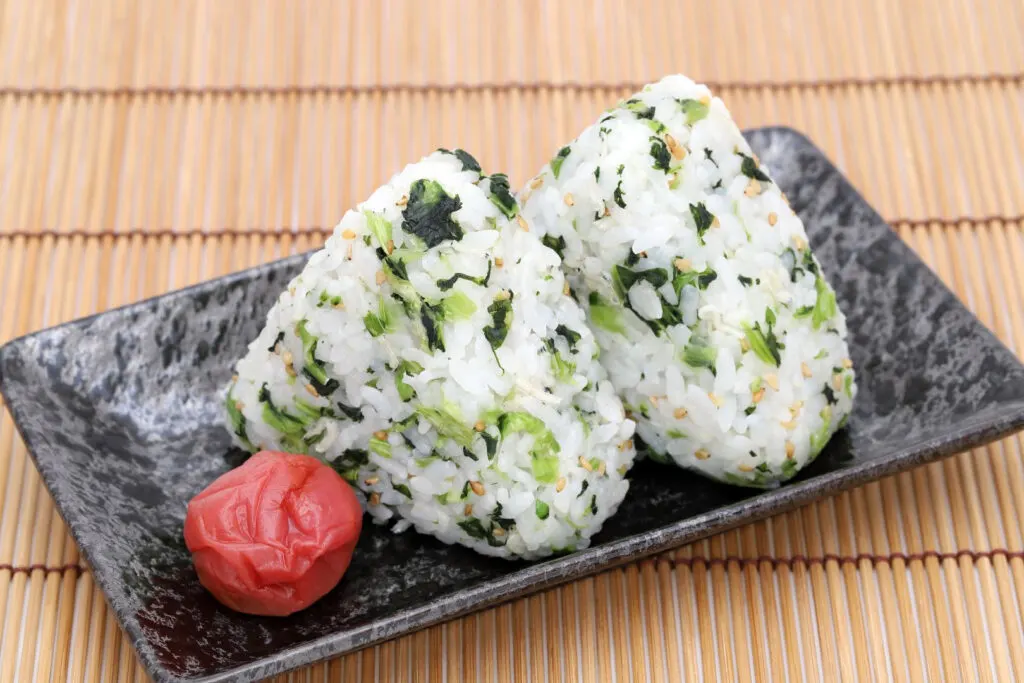
Why are Onigiri Shaped like a Triangle?
There are various onigiri shapes, but the triangle shape is one of the oldest and it is still the major shape today. An interesting theory about the origin of triangle onigiri is that back in the ancient days, people thought that the top of a triangle was like a mountain where gods existed and was thought to be auspicious. So people made onigiri into a triangle shape for luck.
When not in triangle form, you’ll find various round shapes. The oval shape is very easy to eat and to place in a bento (弁当) box, like the ones you eat while watching Kabuki theater. The thin disc shapes are eaten in the northern part of Japan as yaki onigiri (焼きおにぎり, grilled onigiri), and the ball type is often eaten in the Kyushu (九州) area, but is popular all around Japan because it is very easy to form.
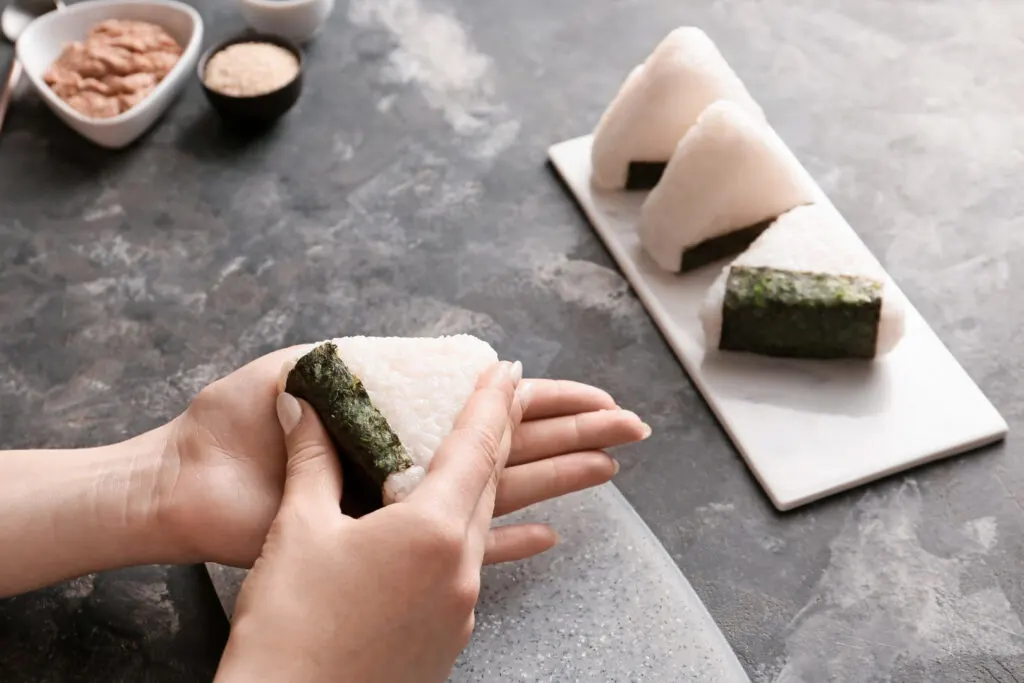
The History of Onigiri, Onigiri Fillings & Seaweed Wraps
If you look into the history of onigiri, it goes all the way back to the Yayoi period (400 BC to 400 AD). Carbonized steamed rice balls from the period were actually found at an excavation site at Sugitani Chanobatake Iseki (杉谷チャノバタケ遺跡) in Ishikawa Prefecture in 1987. But when did onigiri fillings become part of the consumption of this ubiquitous snack?
It was around 1221, during the Kamakura period, that the very first filling was added to onigiri. The first onigiri filling was Umeboshi (梅干し) or salted (pickled) plum. Umeboshi has high nutritional value and also prevents food poisoning, so the military gave their warriors onigiri with umeboshi and it thus became deeply rooted in Japanese culinary culture.
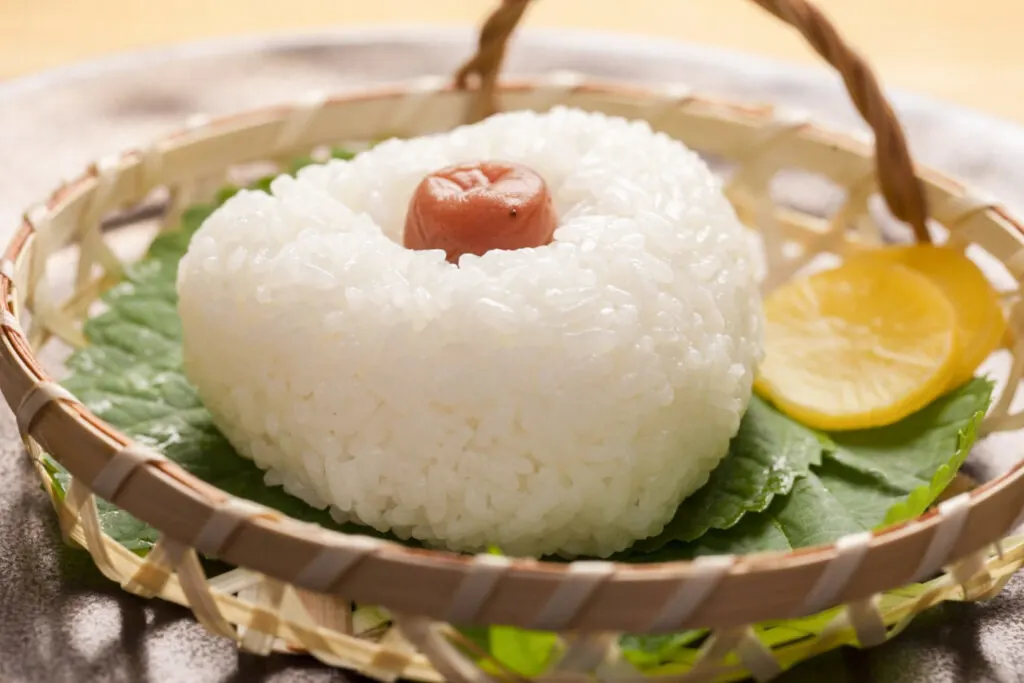
Speaking of history and culture, in the Kansai (関西) area (the region that encompasses Kyoto and Osaka), the seaweed wrapped around the onigiri is usually flavored. Onigiri has been a convenient food for travel for centuries, but in former times the taste of the seaweed as well as the smell (an important part of the enjoyment of food for Japanese people) didn’t last that long.
So in 1869, a year after the Meiji Restoration which saw the Emperor and Capital move to Tokyo, a company in Nihonbashi invented flavored seaweed so that people who traveled west to the old capital of Kyoto could enjoy their bento.
It was not until 1978, that the seaweed around onigiri was crispy. Seven-Eleven invented a special film that can preserve seaweed from getting hydrated before eating and this invention made onigiri the mandatory product for all convenience stores until the present day.
How to Open Onigiri
This plastic film sits between the rice and the seaweed, and is connected to the outer plastic packaging so that you can open your onigiri in a matter of moments in three simple steps. Simply use the numbers on the packaging as a guide.
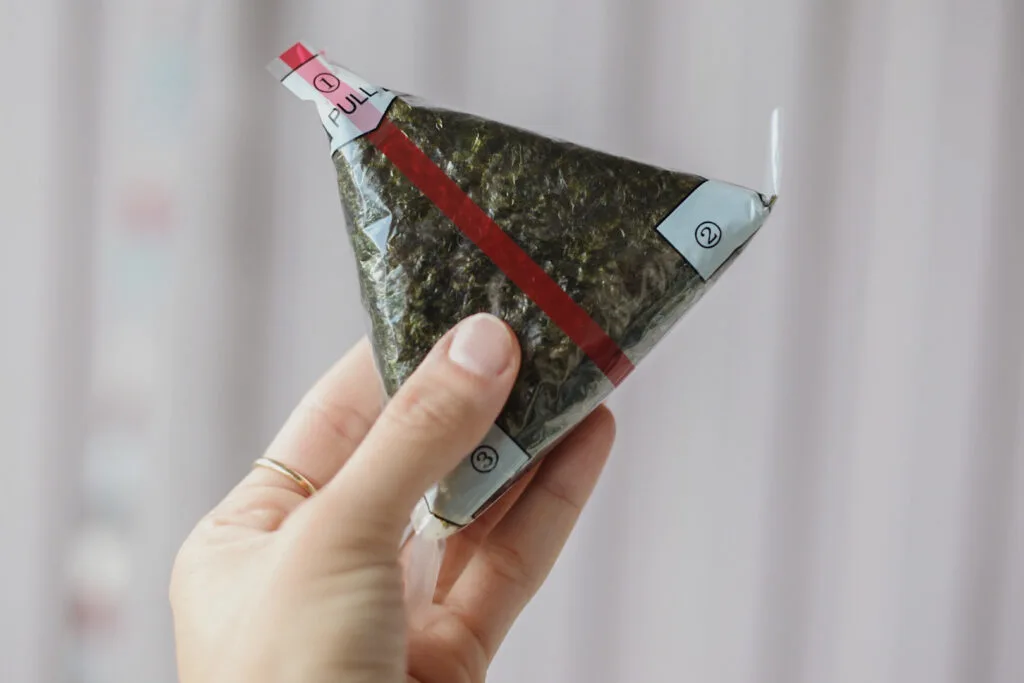
- Pull the tab down from the top (along the red line in the above example) and follow it all the way around the onigiri so that the plastic packaging is now in two halves.
- Then slide the plastic off from the right side, which will also remove the inner film that is separating the rice and seaweed from that half.
- Repeat on the left side.
- Re-fold the seaweed on the top/sides where it may have lifted and enjoy.
So What is Special about Onigiri?
Onigiri is a simple food that even a young child can make with an enormous variety of fillings. It is a regular meal that most Japanese people never think of as something special, but if you look into it deeply, there is definitely something special about it.
Onigiri is a nice quick food when you’re in a hurry or in need of a snack. Onigiri has almost a universal appeal. It is liked regardless of age, and if you avoid hard fillings and serve with less rice, it’s a good option and portion size for the elderly.
Onigiri is also preferred by vegans, vegetarians and those who don’t eat seafood or have food allergies. All you have to do is choose whatever filling you like and you can even eat it without the seaweed, so unless you’re not a fan of rice, this is something that will satisfy your hunger.
So let’s see what kind of onigiri fillings there are.
Types of Onigiri Fillings
Basically, literally any ingredients that don’t contain liquid can be the filling. For example, meat, fish, vegetables and processed foods. You can also combine them, so the number of onigiri fillings is endless. Here are some of the most usual and popular onigiri fillings as well as some fancy ones.
Tuna-mayo
Tuna-mayo (ツナマヨ), or tuna with mayonnaise, has always been the No. 1 filling. There are often competitions about which onigiri filling is the best or the favorite, but Tuna-mayo is always on the top of the list.
This was first sold at Seven-Eleven in 1983 and it has been popular ever since, especially with women. It’s not greasy but very flavorful, it’s easy to make at home and the tenderness is just about right for the elderly.
Okaka
Okaka (おかか) is finely chopped Katsuobushi (鰹節, かつお節, かつおぶし) which is dried bonito mixed with soy sauce. Since it is dried, there’s no worries about food poisoning so it is good to bring for outside activities.
Takana
Takana (高菜) is pickled leaf mustard. Takana has a long leaf and stem so it is often chopped up and mixed with the rice and shaped instead of adding it as a filling in the center of the onigiri.
Mentaiko (明太子, めんたいこ), spicy cod roe, goes well with takana so you see takana-mentai (高菜明太) flavor at convenience stores and other places where you can buy onigiri.
Sekihan
Sekihan (赤飯) is onigiri with Azuki (小豆, あずき) red beans in it. The rice used for sekihan is mochigome (もち米), glutenous mochi rice, which is stickier than usual rice.
Sekihan is a celebratory meal and it used to be eaten only on special occasions, but nowadays, it is sold in onigiri form and eaten on a daily basis. Sekihan typically doesn’t come with seaweed wrapped around it and has a slight sweetness from the sweetened beans.
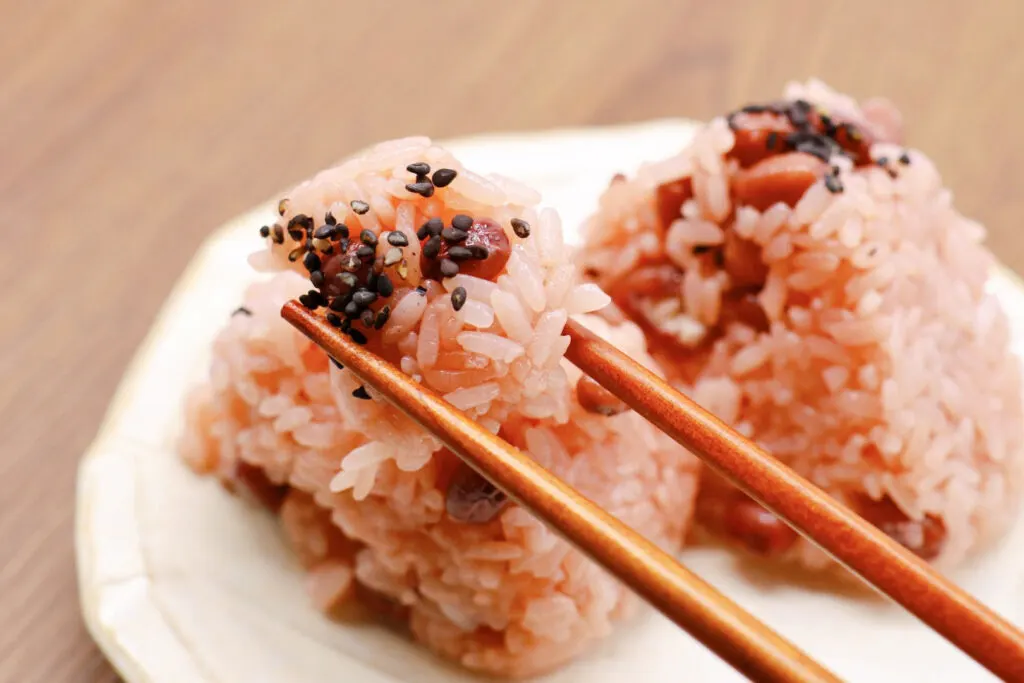
Tenmusu
Tenmusu (天むす, てんむす) is an onigiri with tempura (天ぷら) in it. It started out as a staff meal at a restaurant called Senju (千寿) in Mie prefecture before becoming an official menu item. The restaurant added tenmusu to their menu in 1959 and it became popular nationwide.
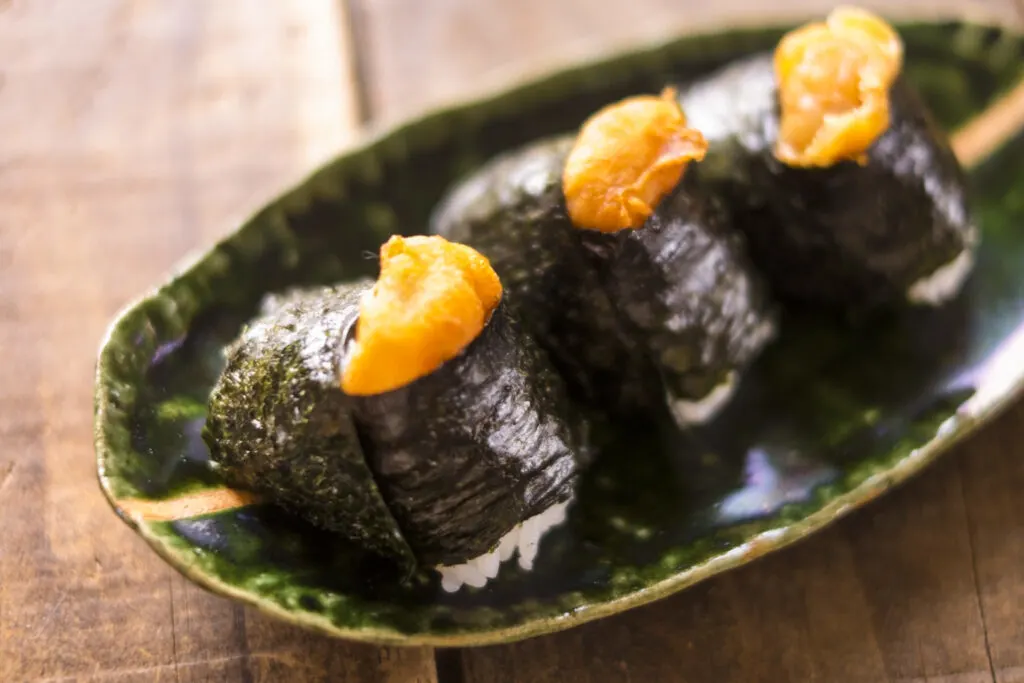
Bakudan
Bakudan (ばくだん) is a unique onigiri. It means “bomb” in Japanese and in line with its name, it is round in shape and has seaweed wrapped around it.
There’s no rule about this filling. You can use any okazu (おかず, a dish that is accompanied by rice) as the filling, such as Japanese fried chicken, known as karaage (唐揚げ, からあげ, カラアゲ), or nitamago (煮卵), soy sauce flavored boiled egg, or even both of them. Kids love bakudan onigiri because they can’t find out what the fillings are until they reach the middle and that makes lunch exciting.
Nikumaki
Nikumaki (肉巻き, にくまき) is onigiri with meat wrapped around it with sweet sauce. The meat used to be a filling, but a company in Miyazaki prefecture produced a wrapped onigiri and it became very popular after the year 2000 when former governor of the prefecture Mr. Higashikokubaru introduced it on TV.
Onigirazu ~the new style onigiri~
You may or may not know, but Japanese people love trends. New openings, new merchandise, and new recipes. A lot of people are seeking fun and joy. It goes the same with onigiri. Japanese who make bento are always looking for a healthy and colorful menu for their loved ones.
Since 2015, Onigirazu (おにぎらず) has been one of the newest onigiri trends. It existed more than two decades ago, but it recently became more popular as a lunch menu.
The meaning of onigirazu is “not shaped” and as its name implies, the shape is square and about an average of 2cm thick. You layer the ingredients just like a sandwich and wrap it up like a present.
First lay down your seaweed sheet and turn it so that it looks like a diamond, rather than a square. Put some rice on top of the seaweed (imagine the seaweed is the wrapping paper, making sure to leave enough space around the edges for wrapping up your square “onigiri sandwich”), then add your fillings, another layer of rice and then wrap the edges of the seaweed over the top to create a parcel.
Plastic wrap (cling film) is usually placed under the nori seaweed sheet at the beginning and wrapped around the parcel upon completion to hold things together. Wait a few minutes for the seaweed to stick together nicely before cutting in half with a sharp knife that has been run under cold water or wiped with a damp cloth to ensure a clean cut. Cut perpendicular to the filling to best showcase the ingredients.
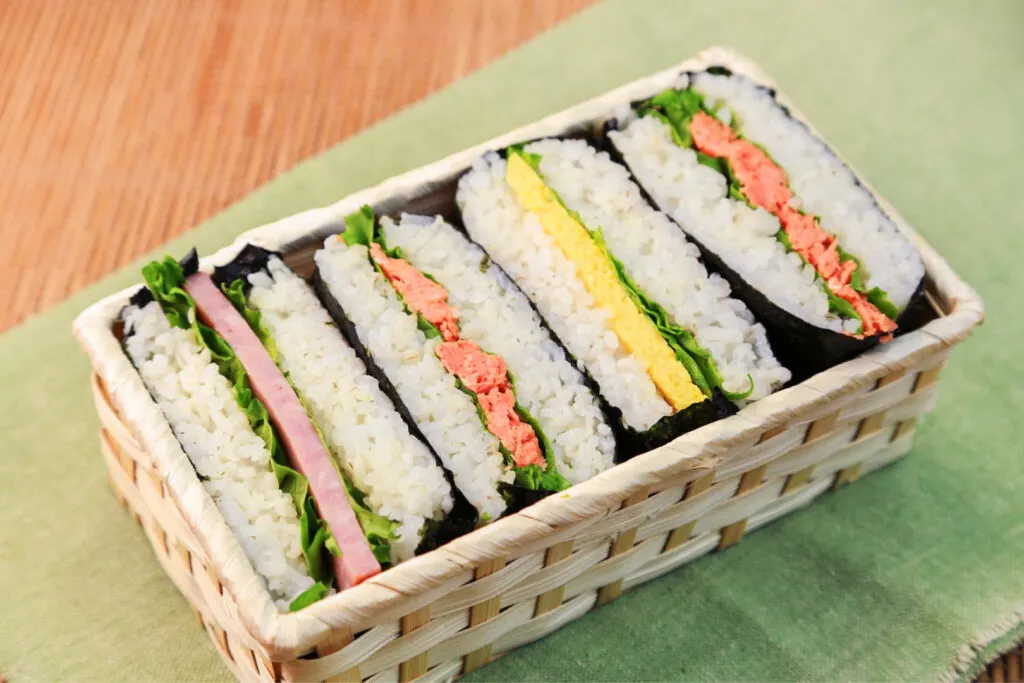
You can have all kinds of fillings. Lettuce is one of the popular fillings for onigirazu. This is because of the presentation of onigirazu. You usually cut onigirazu and if there is something green in it, it looks more colorful and appetizing. There are also Western fillings, like Spam (often eaten with fried egg), which are very popular to young people.
Want to learn about another interesting Japanese take on a sandwich? Why not try a fruit sandwich with bread and cream!
Have you eaten onigiri? What are your favorite onigiri fillings?
Pin me for later
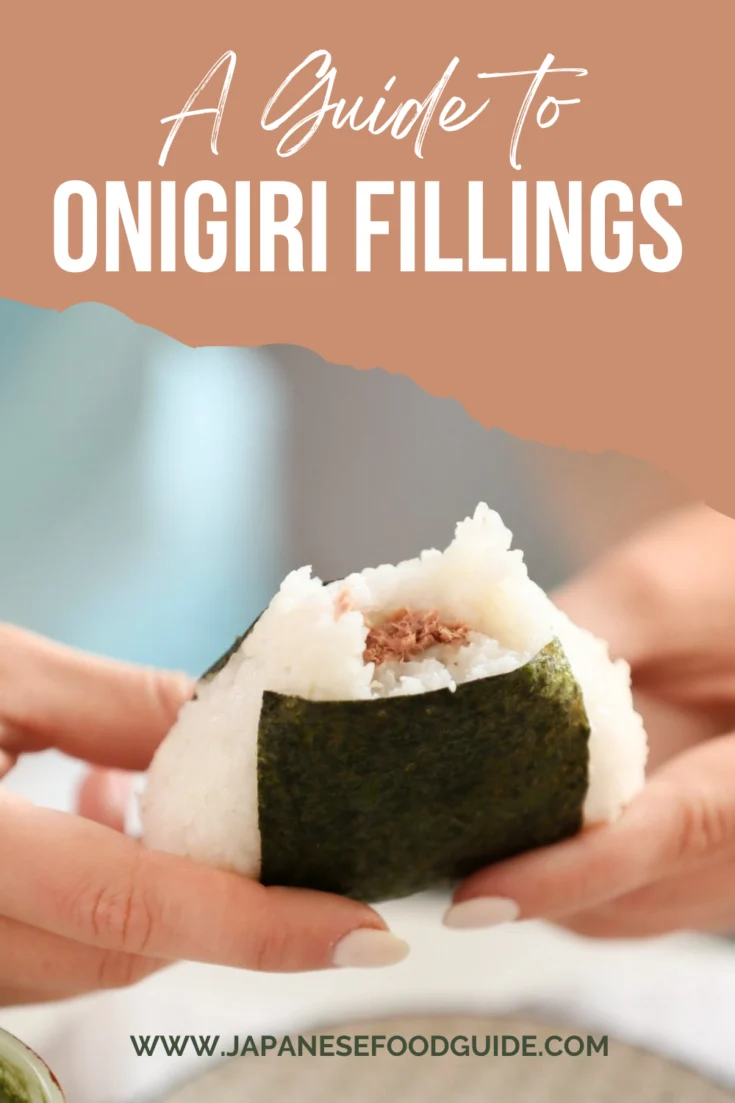
Saki Inoue is a businesswoman and creative who spent four of her formative years at an international school in Germany.
Now based in her home country of Japan, Saki currently works for a real estate company by day and is a freelance worker and pre-release advisor for Adobe Japan by night. She is an expert on social media, casual dining and food trends.

Ken
Monday 20th of March 2023
Hello, Loved your article. My fave onigiri is with abura miso. I had them while in Okinawa.